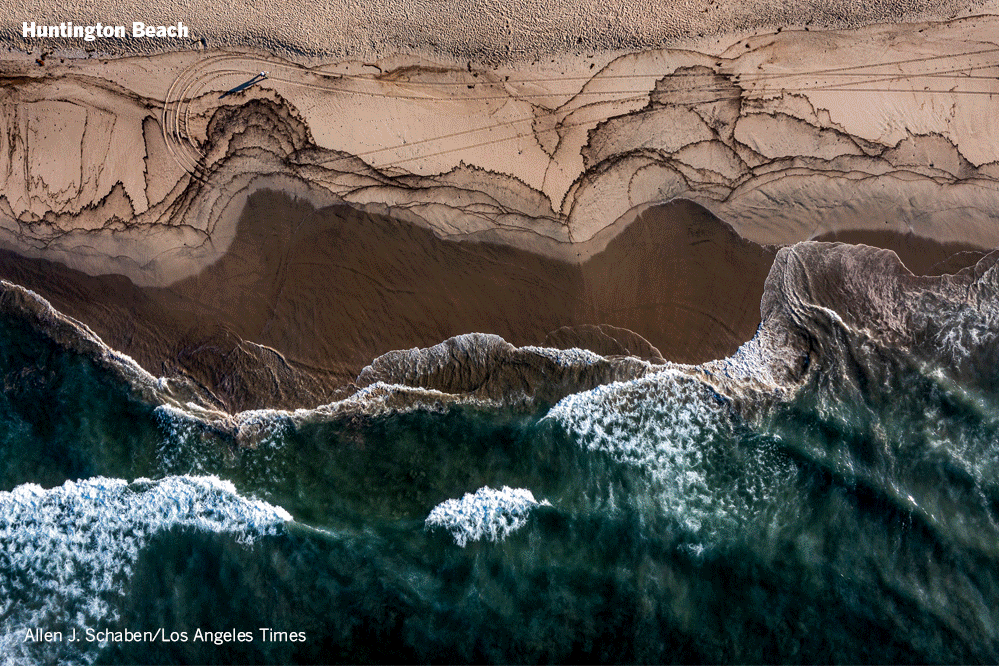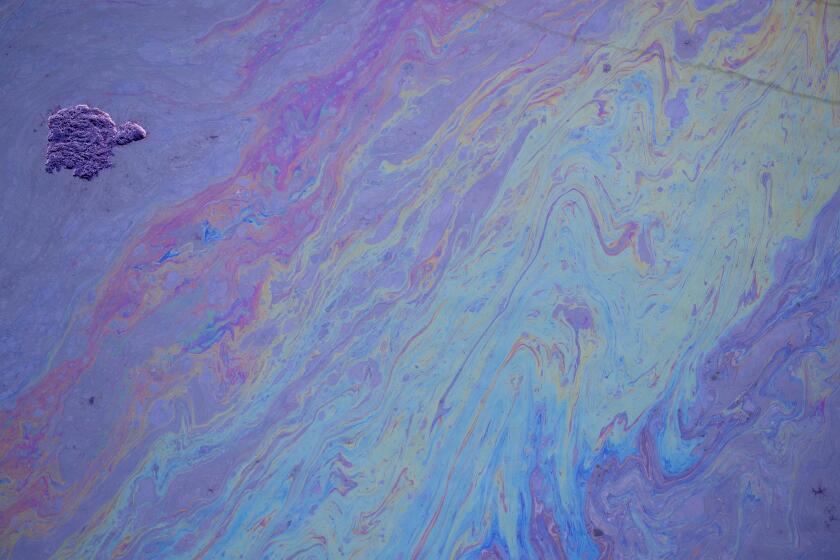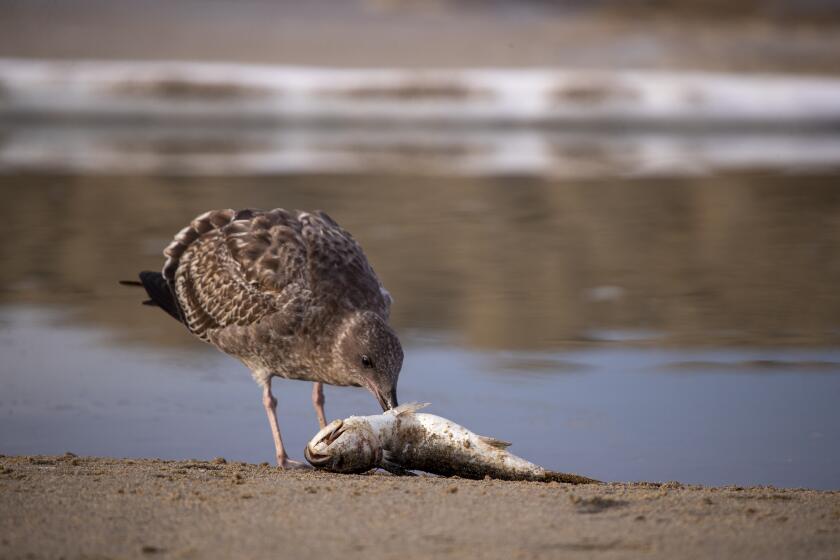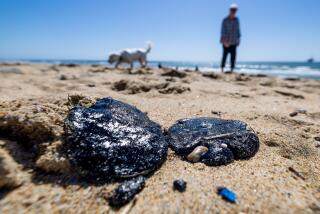
The spill reaches Dana Point, and Baby Beach is closed. The greatest threat to the shore remains in the area between Huntington Beach and Laguna Beach.
- Share via
Coast Guard officials on Tuesday confirmed reporting by The Times that the agency had first been alerted to the possibility of an oil spill off the Orange County coast on Friday evening.
Commercial divers who were hired to examine the suspected source of the leak found an area where the 17.7-mile pipeline had been displaced by about 105 feet; there was a 13-inch split along the length of the pipe. It is not clear what caused the damage to the pipeline, which allowed tens of thousands of gallons of crude to spill into the waters off Orange County.
Investigators have said they are looking into whether a ship’s anchor caused the pipe breach, but officials did not provide more information about that probe on Tuesday. Divers and remote vehicle footage have confirmed that the tear is no longer leaking, officials said.
Rebecca Ore, commander of the U.S. Coast Guard Sector Los Angeles-Long Beach, said that after receiving information Friday night about a sheen on the water, the Coast Guard launched an “initial investigation” that involved calling the reporting party for more information. But that call was “inconclusive” in determining whether the sheen was an oil spill. Ore said the Coast Guard, state and local authorities sent up aircraft at first light Saturday to assess the situation.
Rear Adm. Brian Penroyer said the Coast Guard and Orange County sheriff’s officials went out to sea about 7 a.m. Saturday, and identified oil in the water after 2½ hours. They then launched a much larger deployment of personnel.
“It took about two hours on Saturday morning where we began to detect oil in the water,” Ore said. “And that is when a full-scale mobilization began.”
While officials acknowledged that the spill may have been detected Friday, the agency said in a statement that it frequently receives such alerts.
“These types of reports are common, and in many cases, the sheen reported can be natural seepage of oil or sheen that is never located. [National Oceanic and Atmospheric Administration] satellite imagery was reported to agencies early morning reporting a possible oil anomaly,” the statement read.
Records show that satellite imagery came about 45 minutes after the Friday report and, though inconclusive, determined with “high confidence” that the miles-wide spill was oil.
Martyn Willsher, president and chief executive of the pipeline operator’s parent, Amplify Energy Corp., told The Times on Tuesday that the company first learned of the leak at 8:09 a.m. Saturday. He denied that anyone at the firm was alerted to the leak at 2:30 a.m. by a change of oil pressure in the pipe but would not elaborate, saying the facts would emerge during the investigation. He declined to say when the pipeline was shut off.
However, a 13-page letter sent to Willsher on Tuesday from U.S. Department of Transportation regulators presents a timeline that appears to conflict with Willsher’s statements.
Federal regulators said in the letter that employees in the control room of the subsidiary that operates the San Pedro Bay Pipeline received a low-pressure alarm, “indicating a possible failure,” about 2:30 a.m. Saturday. They added that it took more than three hours for the pipeline to be shut down.
Authorities have told the company the pipeline must stay shut down until there is proof it can be operated safely.
The Coast Guard is continuing to investigate whether a large commercial ship set anchor in the wrong location, damaging the pipeline and causing the spill, an official familiar with the investigation told The Times on Monday. The source spoke on the condition of anonymity because they weren’t authorized to speak publicly.
Coast Guard investigators are examining whether the ship’s captain was aware of the anchor dragging the pipeline. Willsher has said an anchor striking the pipeline was “one of the distinct possibilities” for the spill. He described the break as pulling the pipe in almost a “semicircle.”
“The pipeline has essentially been pulled like a bowstring,” he said.
Coast Guard investigators have come up with no other explanation for the break other than anchor drag, federal sources said. There were multiple large cargo vessels in the area before the oil was spotted and reported.
“This is a terrible tragedy, and we are extremely sorry this happened,” Willsher said. “The cause of this will still need to be investigated, but regardless of the cause, we are going to do everything we can to make things right for all of those impacted areas and individuals as quickly as we can.”
Officials on Tuesday continued frantically trying to protect ecologically sensitive shorelines. The oil has continued to move south after fouling beaches and wetlands in Huntington Beach on Sunday. While much of it remained off the coast, some washed up in Newport Beach, Laguna Beach and Dana Point, prompting officials to close harbors and large stretches of sand. State parks officials closed Bolsa Chica State Beach on Tuesday after officials observed oil in that area, which is slightly north of Huntington Beach city beaches.
The spill was initially estimated at 126,000 gallons of crude, but state and federal officials said the number could be closer to 144,000 gallons.
The spill has renewed calls to end offshore drilling. Gov. Gavin Newsom said during a news conference Tuesday afternoon at Bolsa Chica State Beach that it’s “time once and for all to disabuse ourselves that this has to be part of our future.
“This is part of our past, and we can moralize and talk about the good old days, we can talk about how important these rigs had been to the prosperity of this country and the middle class, but at the end of the day, this is about the stale air of normalcy versus the fresh air of progress,” he said.
A NOAA map projecting the movement of the spill, reviewed by The Times, indicated that the greatest threat to the shore remains in the area between Huntington Beach and Laguna Beach.
Coast Guard officials are flying over the spill three to four times a day to map its movement and compare it with tides, currents and winds to project the potential impact to beaches to the south.
“It really is dependent on the prevailing weather conditions, but the oil continues to move in a southerly direction,” said Ore of the Coast Guard.
The oil likely will continue to encroach on Orange County beaches for the next few days, officials said.
The oil has been detected as far south as Dana Point, but officials are preparing for it to eventually reach San Diego.
“I would characterize it as isolated ribbons of oil, or patches of oil. It’s constantly changing,” Ore said. “It’s not one large slick of oil covering this large area of miles.”
The Orange County Board of Supervisors enacted a declaration of emergency response during its meeting Tuesday, which allows the county to seek reimbursement for cleanup and other efforts from the entity responsible for the leak. Newsom declared a state of emergency late Monday.
“We do need more resources,” Orange County Supervisor Katrina Foley said. “It looks like they have one boat doing skimming off of Laguna Beach, kind of heading toward Dana Point. However, there are threads of oil that are just sitting out there, so more resources — more skimmers — are needed. We must be all hands on deck.”
Surveys found that the spill hasn’t penetrated the Bolsa Chica wetlands in Huntington Beach. However, a significant amount of oil has seeped into Talbert Marsh, a 25-acre ecological reserve across from Huntington State Beach that is home to dozens of species of birds. County officials have set up berms to keep out additional oil.
“It’s just devastating how much oil is just settling in there,” Foley said. “That marsh was actually something that was repaired after the last oil spill, and so we’re back to ground zero for that.”
On Tuesday morning, a yellow bulldozer pushed sand toward the mouth of the Huntington Beach Channel, creating a barrier that officials hoped would slow the oil that was floating up to the nearby wetlands. Farther up, in the underpass, cleaning crews on two boats began to replace booms, oil-containment barriers, that had absorbed some of the oil. Two men picked up the blackened booms and placed them in a translucent bag.
“This has been a very long 72 hours, and we’re not out of the woods yet,” said Huntington Beach Mayor Kim Carr. “We will not stop until everything is restored to its natural beauty.”
The full scope of the weekend oil spill in Orange County remains unclear.
Fourteen boats are working in the waters along the coast to recover oil before it washes ashore, according to the Coast Guard. The cleanup efforts were halted for several hours overnight because lightning made it too dangerous for crews to be on the water, officials said.
More than 4,700 gallons of oil had been removed from the water as of Tuesday, but there is light oil remaining along 15 miles of shoreline. Officials deployed 8,700 feet of booms to protect the coast, according to the Coast Guard.
On Tuesday morning, antipollution vessels were seen again off the coast of Huntington Beach, south Laguna Beach and Dana Point. Officials in Laguna Beach hoped the skimmers would prevent more oil from coming ashore.
“People call it the California Riviera. It’s just so beautiful,” Laguna Beach Mayor Pro Tem Sue Kempf said. “And people who live here, they’ll go and pick up trash on the beach. They’re very protective. They treat it like their own beach.”
California officials received reports of oil in the waters off Huntington Beach on Friday evening, records show.
The oil will likely continue to encroach on Orange County beaches and environmentally sensitive habitats for days, officials said.
Michelle Anderson, the county’s director of emergency management, compared the accident to the 2015 Refugio oil spill in Santa Barbara, which she said took about four months to clean up.
“This is definitely not going to be a short-term incident,” she said.
Eight birds with oil on their bodies — including a brown pelican, a ruddy duck, an American coot, an eared grebe, a sanderling and a Western grebe — have been recovered in the wake of the spill.
Greg Viviani, a Laguna Beach native, was walking his dog Monday morning on Aliso Beach when he noticed a bird splashing in the water. Aware of the oil spill, he ran to the shoreline, where he saw the bird getting tossed in the break and pummeled by waves.
“This bird’s going to drown,” Viviani recalled thinking. “There was oil all over the thing. It totally looked like it was struggling.”
After it got pushed up onto the sand, Viviani ran over, draped his black T-shirt over it and gently picked it up.
“People are like, ‘Don’t approach the animals, you’re going to hurt yourself or the animal.’ But I wasn’t going to let the thing just drown,” the 37-year-old said. “I wasn’t thinking of that. I was thinking that I’m a human, and this is an injured animal, and I’m going to try and help it out.”
Times staff writers Connor Sheets, Ruben Vives and Brittny Mejia contributed to this report.
More to Read
Sign up for Essential California
The most important California stories and recommendations in your inbox every morning.
You may occasionally receive promotional content from the Los Angeles Times.
















